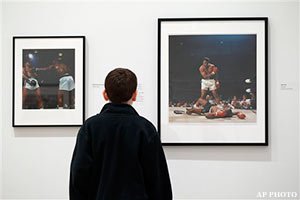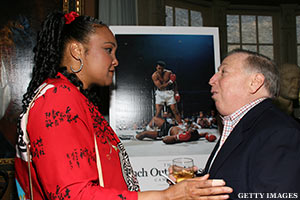In 2011, ThePostGame sat down with famed sports photographer Neil Leifer for a wide-ranging interview about his career, which included some of Muhammad Ali's most iconic shots. With Ali's passing Friday at 74 from a respiratory issue, we have excerpted the interview to feature portions relevant to the man simply known as The Greatest.
TPG: Let's talk about when you're 16 and you find yourself on the field of what turned out to be the greatest NFL game ever played, the Colts-Giants championship game in 1958. How did you shoot what ultimately became one of the most iconic pictures in sports history?
LEIFER: Well, I'm going to preface this by saying I've never met a good sports photographer or photographer who didn't have a healthy ego, so when I use the word luck, I am not being modest. Luck in sports photography is everything and what separates the really top sports photographer from the ordinary is that when he or she gets lucky, they don't miss. That is the key. But you have to be lucky. For example, my best known picture, Muhammad Ali standing over Sonny Liston, the guy between Ali's legs was an old established boxing photographer, great photographer Herb Scharfman. I don't care how good he was that day; he was in the wrong seat. He was looking up at Ali's rear end and that's the only picture he could get. I was obviously in the right seat, but what matters is I didn't miss.

The game that you refer to, the greatest game ever played, was the sudden death game with the Baltimore Colts and the New York Giants, was on my 16th birthday on December 28th, 1958. And that season I couldn't even afford the cheapest ticket to a Giants game. And furthermore what kind of pictures could you shoot from the stands? You were a million miles away. But I found out early that season that every Sunday, there was an Army Veterans Hospital in the Bronx that would bring anywhere from 40 to 60, 70 Army veterans in wheelchairs to the games, and they always needed help. They never had enough people to wheel these people in. In the late '50's, there was no law that made stadiums wheelchair accessible, so they weren't. The only place you could actually bring these wheelchairs was right on the field along the outfield wall. Well, that put you on the field.
TPG: When you shot it did you have any sense at that moment that you may have gotten The Shot of that game?
LEIFER: Oh, God, no, no. It isn't the picture I wanted to shoot. When I first saw the picture, I knew I had a nice picture, but I wished I could've had it closer and filling the frame just like the pros did. It took a long time before the picture got any recognition.

You have to understand, a lot of pictures aren't appreciated when they're first taken and they get a life of their own. The best two examples I can give you are my two best-known pictures, Muhammad Ali standing over Sonny Liston and Ali-Cleveland Williams, which is a remote camera looking down, which is my favorite picture ever. The London Observer did a Sunday magazine piece a few years ago in which they listed the 50 greatest sports photos of all time. I was happy to see Ali-Williams was No. 1 and Ali-Liston was No. 2. At the end of the century when Sports Illustrated did the greatest sports photos, they put Ali-Liston on the cover.
Well, let me tell you about those two pictures. In 1965 when I shot Ali-Liston, there was a contest. I don't want to say it's as important as the Oscars, but in photojournalism it was. It still exists and is sponsored by the University of Missouri and it's called "Pictures of the Year." Time, Inc. was very big in entering it. Life magazine used to win every year, all sorts of awards. Sports Illustrated did. So we entered Ali-Liston. And you know what? Isn't it interesting, the picture that was their photo of the century? It didn't win first place. It didn't win second or third. In fact, it didn't win any of the three honorable mentions. And it didn't make the cover of Sports Illustrated the week of the fight.

How interesting that today it's considered the greatest. Why? Because Ali's reputation grew and the picture grew along with him and it's the way people want to remember Muhammad Ali at his greatest and his best. Ali-Williams, one year later, I thought a sure winner. It didn't win first, second, third or honorable mention again; and years later it's been picked as the best picture by The London Observer where I don't know these people. I mean, this wasn't my uncle running the paper.
TPG: Is there a shot that you thought you nailed but then discovered you didn't, or any one that you wished you'd gotten?
LEIFER: Walter Iooss was my No. 1 competitor all these years, and the one thing that Walter didn't like, couldn't stand, as much as he was a great football photographer, was the cold. And of course there's the famous Ice Bowl in Green Bay with the Dallas Cowboys and the Green Bay Packers. Walter was dying all game. And I had a very good day; all the plays happened right in front of me. Everything went right. And when there's a big touchdown or a big interception, you sort of look over to see where your competitor is and I realized that I was in a good spot and he wasn't. So the probability is I had a better picture.
And that went on for 59 minutes and 57 seconds or whatever, and then Green Bay lined up for the last play of the game, which turned out to be Bart Starr sneaking in for the winning touchdown. Bart Starr went in for the touchdown and the first thing that happened is the referee got between me and the play. And it happened right in front of Walter, and I knew. I looked at Walter and I said there's no God. Ha. Walter got the opening spread and he was the hero. I knew Walter wouldn't miss, but the fact is that for 59 minutes and 57 seconds, I was kicking his butt, and then all of a sudden, bingo. And Walter did exactly what Walter always did, he got a great picture.

Another example was the first Ali-Frazier fight. For 14-plus rounds, I had a real good night. My competition was Tony Triolo on the other side of the ring, and this time, I was Herb Scharfman between Ali's legs. In the 15th round Joe Frazier knocks Ali down. It couldn't have been a worse spot. The referee was between me and the fighters, and even if he weren't, I was looking at Frazier's butt -- just like Herbie was looking at Ali's butt. I couldn't see. What I'm proudest of is I actually got a picture that was usable, but I knew I didn't get the cover of the magazine. It happened right in front of Tony Triolo and he didn't miss. He got it and it was a great cover.
More Ali:
-- Muhammad Ali Responds To Donald Trump
-- When Bush Gave Ali Presidential Medal Of Freedom
-- Watch Muhammad Ali KO Sonny Liston In First Round Of Rematch





